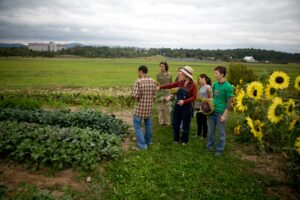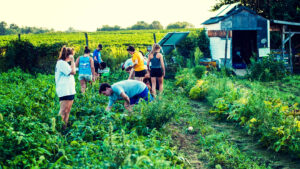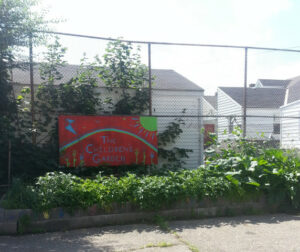Introduction
The social context for this project stems from the evolution of farming in conjunction with the recognition of climate change. The greenhouse we propose here is a result of considerations for both of these factors and help sustain the objectives for future development. In an effort to progress the carbon neutral greenhouse to be installed at Lafayette College’s LaFarm site, our Capstone group was prudent and judicious in carefully considering the social context of each step of our decision making process. We initially discuss the effects of the greenhouse within the LaFarm community itself. Widening the scope of the effects of the greenhouse demonstrates the beneficial outcomes that would emerge on Lafayette’s entire campus, whether students are aware of it or not. The largest community that is important to consider is Easton as a whole as the greenhouse will not be a silo of involvement strictly meant for Lafayette students. Understanding the larger movements behind the carbon neutral greenhouse as well as smaller-scale benefits that will affect the local community allowed our social context to develop more fully at every step of our decision making processes.
Why are we doing this?
While there are plenty of local benefits of a greenhouse, there are also two important movements behind the initiative that are part of something much bigger. Industrial agriculture puts a considerable strain on the environment and natural resources. Consequences of large agriculture practices include “land degradation, losses of biodiversity, excessive use of pesticides…excessive emissions of carbon and criteria pollutants, animal waste disposal, etc.” (Sexton). Industrial agriculture practices stereotypically do not consider these factors while building their business models and deplete critical natural resources as a result. The sustainable agriculture movement has been gaining momentum since the middle of the 20thcentury and addresses a number of environmental concerns surrounding the effects of farming malpractice including but not limited to: non-renewable resources and their evanescence, ecological disasters, and the conservation of water and soil (Ganzel). As climate change becomes more and more evident to the public, it is critical to reevaluate industrial operations to reduce the carbon footprint, and farming is no exception. While smaller scaled farms are not necessarily as lucrative as massive agriculture giants, they usually demonstrate much more environmentally friendly conventions and benefit the community around them in a myriad of ways. The carbon neutral greenhouse proposed here fits into this initiative for environmental regulation by avoiding immutable effects of industrial agriculture. Not only will the building itself support the sustainable agriculture movement, but it will also involve all who purchase produce from LaFarm in the operation.
With the development of sustainability in commercial farming comes the development of sustainability in university farming. Agriculture programs are offered at a legion of schools in the United States alone, and they too have to keep up with the ebb and flow of acceptable farming customs. Educational opportunities in the realm of agriculture are no different in that the most successful and well known sustainable agriculture programs are not found on small liberal arts campuses but rather at large universities with the space and resources to farm on a very large scale. The Chico campus of California State University is a well-rounded example of large schools dominating the agriculture study space with its 16,000 students and modern understanding of farming initiatives. Chico’s Center for Regenerative Agriculture and Resilient Systems “[seeks] to promote regenerative farming practices to reduce greenhouse gases, restore soil resiliency, increase the sustainability of farms and ranches, and address food and water insecurities” (Welcome). All of these published objectives provide a liaison between the sustainable agriculture movement and the college farm movement, which seek to provide an educational opportunity into sustainable farming practices, and can help other large schools transition their farms into sustainable enterprises.
Remarkably, some of the best-rated college farms are located on campuses with exceptionally small student bodies. According to College Values Online, Berea College in Kentucky is rated as the top sustainably run college farm. At only 1,600 students, the college farm lies on about 500 acres and has a goal to “serve as a model of sustainable agriculture [which is] broadly defined as being: ecologically sounds, socially acceptable, economically viable, and humane” (BEREA). Ranking such a small institution so highly in terms of sustainable agriculture demonstrates the viability of other institutions with modest student bodies to follow the movement. Because Berea has a legitimate agriculture discipline, perhaps a more suitable comparison to the initiative at Lafayette is Middlebury College’s farm whose “mission is to use food as a medium to cultivate wellbeing in people, place and the planet” through its Environmental Affairs staff and Organic Farm student organization (Middlebury). Like Middlebury, Lafayette joined the broader movement for sustainable agriculture by starting its own farm three miles from campus, which has since proven to have an incredible effect on a number of actors in the Easton community. Since the emergence of the Climate Action Plan 2.0 in February of 2019, which pledges to make Lafayette a carbon neutral campus by 2035 and is further discussed in the following sections of this report, a much higher degree of scrutiny has been placed upon making all facets of Lafayette’s operations environmentally friendly. LaFarm, Lafayette’s learning and working farm, is included in the effort to achieve carbon neutrality, which has proven challenging in that the farm community obviously wants the enterprise to develop while also keeping in mind that all developments must be sustainable.

Figure 1: Middlebury College Farm (McNiff)

Figure 2: LaFarm at Lafayette College (LaFarm)
Our Engineering Studies capstone group comes into play at this intersection between maintaining LaFarm within the college farm movement while also keeping up with the sustainable agriculture movement. This fall, we inherited the carbon neutral greenhouse from students who developed their own conclusions while working on it in 2015, 2016, and 2017. Our iteration of this analysis is centered on the technical systems that will be put in place within the greenhouse and how to maintain our place within the sustainable agriculture and college farm movements.
LaFarm Actors
While the sustainable agriculture and college farm movements are critical objectives to understanding the context of the carbon neutral greenhouse, there are also smaller-scale aspirations to the project. Lisa Miskelly is the key manager for development at LaFarm. She runs day-to-day operations on the farm and will be the primary beneficiary of the greenhouse. Farmer Miskelly currently has to choose and purchase her seedlings from a third party source, which is time intensive and costly. With the introduction of the greenhouse, Farmer Miskelly’s and her student employees’ labor would be reduced. While the system itself does offer the opportunity to elongate the growing season for LaFarm, which would seem to create more work for employees, the care and keeping of seedlings is not supposed to be a time intensive process. With this in mind, our greenhouse will be simple enough to demand little maintenance but will also serve as a skeleton to house automated processes in the future, which would reduce labor even more drastically.
The second actor to consider in LaFarm’s direct network is the student body that works alongside Lisa Miskelly. Currently, only 20 to 25 students are employed throughout the growing season; while Lisa does not intend to hire more students to work in the greenhouse, their timelines of employment would be extended with the chance to start gardening earlier in the year. In other words, the projected outcome of the greenhouse is not to involve more people but to extend the length of time each employee is working on the farm. Because Lafayette does not offer an agricultural program, LaFarm presents a unique opportunity for students to spend time outside, learn about horticulture, field a paying job, and build upon their extra curricular activities. This is in line with the Climate Action Plan’s endeavor to become carbon neutral, allowing the learning outcome to translate well.
Lafayette Actors
The Lafayette campus as a whole also structures the operations at the farm. The educational opportunity that evolves from developing a greenhouse at LaFarm extends to multiple departments. Classes like the Engineering Studies capstone clearly present a learning opportunity for students to apply their engineering background to a project with tangible outcomes. Secondary to Engineering Studies students’ involvement is the suggestion to have other engineering disciplines associated. Considering the focus of our project is on the technical systems of the greenhouse, consulting the mechanical engineering department to ensure our systems are as efficient as possible would be in the best interest of the college. Another option to consider is involving Engineers Without Boarders. A member of Lafayette’s division of the organization reached out to our capstone group and explained that the group is interested in taking over the project. “We have a sizeable group of people who have been trying to find some hands-on projects on campus or in the Easton community in which to involve ourselves as we work to restart the club,” said Liz Rohricht, a third year Mechanical Engineering student at Lafayette. The team understands the restrictions that exist surrounding building permits and zoning codes, but they are more than willing to work within the system to get some exposure to a project like this. Involving Engineering Without Boarders here at Lafayette would serve a twofold purpose in that, firstly, college students could apply their knowledge to a new learning opportunity and secondly that the project would be a major stepping stone in promoting the success of the club on campus. As a final consideration for potential educational opportunity, environmental studies students can observe this as an example of applied carbon neutral technology. Lafayette has very vague next steps outlined for the Climate Action Plan on campus, and demonstrating tangible project plans might incentivize environmentally conscientious students to take a deeper dive into more carbon neutral outcomes for Lafayette.
Easton Community
Looking beyond Lafayette as a silo of involvement in the effects of the LaFarm greenhouse, the Easton community as a whole has a wealth of opportunities to be included. One of Farmer Miskelly’s goals for the greenhouse’s outreach was to sell plant starts to the Easton community gardens. Opening a channel of communication to community members would not only improve relations between Lafayette and Easton, but it would also involve a large community in the sustainable agriculture and college farm movements. Community members could start their own at-home gardens, which would further the effects of carbon neutrality as they would no longer purchase produce from third party vendors who may not practice environmentally conscious farming. On a broader scale, community gardens are scattered around Easton; Farmer Miskelly would like to sell starts to these gardens to not only make a profit but also to similarly spread environmental awareness and lessen the carbon footprint of the entire city. The most important objective to glean from this goal is that Lafayette students are aware and actively looking to reevaluate not only the relationship Lafayette has with the city of Easton but also the extent of environmental impacts every decision we make has on society.

Figure 3: Easton Community Gardens (Community Gardens)
Conclusion
The objective of this section is to delineate why this project is a worthy undertaking as well as the importance of the campaigns behind it. The broad sustainable agriculture movement and the college farming movements that encouraged Lafayette to start its own farm are instrumental in understanding why we are taking the time to develop this project. Further, the consideration for Lafayette’s Climate Action Plan only adds to the notion of sustainability within the farm. More specifically, the semantics of the greenhouse’s systems would not be educated decisions without our ample meetings with Lisa Miskelly. While the greenhouse seems like such a small project in the grand scheme of Lafayette College, it has become clear to our group—and hopefully others reading this report—that the effects of such a system are far reaching. Not only will the produce grown in the LaFarm greenhouse create a network within the entire city of Easton, it is also taking a step towards effectively promoting carbon neutrality.
In our next section, we discuss the political context of the project.